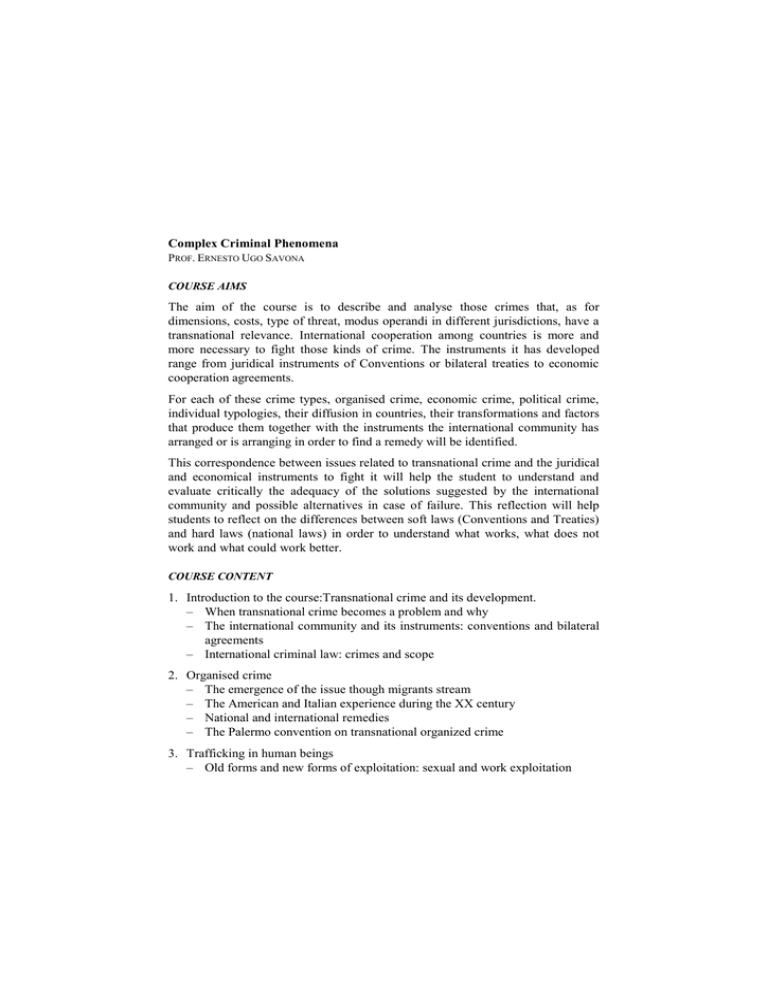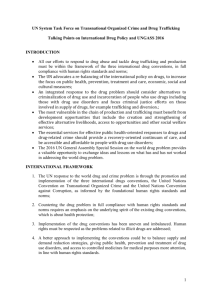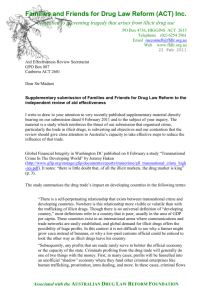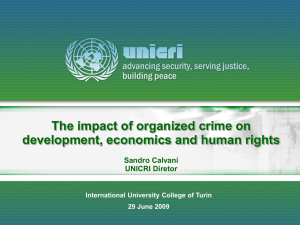Complex Criminal Phenomena
advertisement

Complex Criminal Phenomena PROF. ERNESTO UGO SAVONA COURSE AIMS The aim of the course is to describe and analyse those crimes that, as for dimensions, costs, type of threat, modus operandi in different jurisdictions, have a transnational relevance. International cooperation among countries is more and more necessary to fight those kinds of crime. The instruments it has developed range from juridical instruments of Conventions or bilateral treaties to economic cooperation agreements. For each of these crime types, organised crime, economic crime, political crime, individual typologies, their diffusion in countries, their transformations and factors that produce them together with the instruments the international community has arranged or is arranging in order to find a remedy will be identified. This correspondence between issues related to transnational crime and the juridical and economical instruments to fight it will help the student to understand and evaluate critically the adequacy of the solutions suggested by the international community and possible alternatives in case of failure. This reflection will help students to reflect on the differences between soft laws (Conventions and Treaties) and hard laws (national laws) in order to understand what works, what does not work and what could work better. COURSE CONTENT 1. Introduction to the course:Transnational crime and its development. – When transnational crime becomes a problem and why – The international community and its instruments: conventions and bilateral agreements – International criminal law: crimes and scope 2. Organised crime – The emergence of the issue though migrants stream – The American and Italian experience during the XX century – National and international remedies – The Palermo convention on transnational organized crime 3. Trafficking in human beings – Old forms and new forms of exploitation: sexual and work exploitation – Supply and demand: changes in trafficking in human beings patterns: push and pull factors connected to migrations – Trafficking in human beings, crime organizations: routes, prices, modus operandi (case studies: Eastern Europeand North Africa) 4. Illicit drugs: cultivation, trafficking and consumption – History of the problem between XIX and XX century – The dimension of the problem today: heroin, cocaine, marijuana, synthetic drugs – UN conventions on illicit drugs – Prohibition, anti-prohibition and damage limitation – Routes of illicit drugs trafficking and their variations 5. Laundering of Money resulting from criminal proceeds – The three phases: accumulation, stratification, investment – The 40 recommendations of the Financial Action Group of 1989 and different integrations – The Council of Europe convention on seizure and confiscation – Offshore countries and OCSE mechanisms for the harmonization of anti money-laundering and corporate regulations – Routes of international money-laundering – The World Bank and the International Monetary Fund on laundering of illicit wealth – The third EU anti money-laundering directive – Explorative analysis of investments portfolio of criminal organizations in Italy and in Europe 6. Terrorism – History of the problem and its different dimensions – International community against terrorism – Terrorism after 9.11.2001 – Technologies and fight to terrorism 7. Corruption – Corruption markets: supply and demand – National Law – International corruption – International cooperation instruments: UN convention on corruption – The International World Bank – OCSE convention on international corruption – The European dimension and European instruments to fight international corruption 8. Cybercrime – Computer crimes and computer related crimes – International conventions on the matter – Computer fraud 9. Conclusions: resuming the phenomena and the international community instruments to fight organised crime. READING LIST For students attending the course: lecture notes and material posted on the lecturer’s webpage; for students unable to attend the course: a textbook indicated during the course. TEACHING METHOD Lectures and seminars. ASSESSMENT METHOD At the end of the first term, full-time students will have to write a paper on course topics. This test will count towards the assessment of the final examination. Full-time students will have to write a paper also in the second term. NOTES Further information can be found on the lecturer's webpage http://www2.unicatt.it/unicattolica/docenti/index.html, or on the Faculty notice board. at







